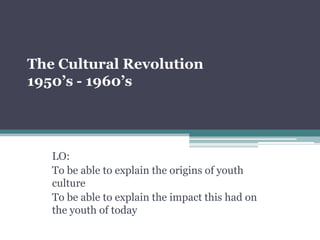
Group 1 lesson 15
- 1. The Cultural Revolution 1950’s - 1960’s LO: To be able to explain the origins of youth culture To be able to explain the impact this had on the youth of today
- 2. The Cultural Revolution • What had just happened before the 1950’s? • Britain was entering a period of increased freedom and affluence • Many of the old social cultural structures began to be challenged, especially by the young • What do you think changed and how might this have changed the way in which the British lived?
- 3. The Cultural Revolution ▫ Rationing was coming to an end (officially ending in 1954) ▫ The American way of life had started to become key to the aspirations of the British public (both culture and material goods) (deregulation of broadcasting in 1954= introduction of Commercial TV) ▫ Increased availability of cheap colour magazines brought a proliferation of advertising for luxury commodities, much of it originating in America ▫ A world wide economic boom (post-war regeneration schemes) ▫ After WWII Labour took over from the Conservatives introducing several post war reforms. ▫ In 1951 Labour was defeated by the Conservatives. This change in government marked a shift from state control to increased individual freedom the Conservative election slogan promised to ’Set the People Free’. ▫ Youth given more freedom through the deregulation and commercialisation of society
- 4. America’s Influence • Whether you lived in London, Glasgow, Cardiff or even Wolverhampton, to be young in the mid-1950's usually meant that you consumed almost anything that had 'made in America' • American culture was viewed by some, as a symptom of cultural degeneration • However Hollywood movies, commercial T.V, glossy magazines and consumer goods proved an instant hit with British consumers • To the average Briton it offered a rich and desirable future. • Cultural imperialism – Cultural imperialism is the practice of promoting, distinguishing, separating, or artificially injecting the culture of one society into another (America influence on Britain post-war) -
- 5. The Cultural Revolution • Massive increases in the production and availability of consumer goods stimulated mass consumption. • People expected to have goods such as televisions, refrigerators, music systems and cars as a basic requirement. Before the war these had been luxury items available only to the most privileged sections of society. • Car ownership rose by 250% between 1951 and 1961, and between 1955 and 1960 average weekly earnings rose by 34%, while the cost of most technological consumer items fell in real terms. In the 1950s consumers had more money to spend on goods, and more goods from which to choose.
- 6. The Cultural Revolution • By the 1960s consumption had become less connected with utilitarian needs, and more to do with status and comfort (Maslows Hierarchy of Needs) • The era of the ‘lifestyle’ had begun, and specialist retailers began to spring up, providing outlets where people could buy into a new identity based around design or fashion. • Teenagers became a recognised social group, and as they in turn became more affluent, they demanded goods that could differentiate them from the adult world and express their group identity.
- 7. The Cultural Revolution • Manufacturers were only too happy to meet this demand, products reflecting an increasing interest in fashion and pop music, began to be developed and sold. • As youth culture became more dominant, these attitudes rapidly spread among other social groups, and for many people their consumption choices began to underpin their personal identity.
- 8. Social Mobility • As a result of the state-funded education system, many children from working class families had gone on to study at college and university. • Higher education, together with increased affluence, helped to create an increase in social mobility, and with it a blurring of the old class-based distinctions between High Culture and Mass Culture. • Establishment values began to be questioned, and sometimes even ridiculed, in television and radio shows, satirical magazines and films.
- 9. Social Mobility • Many of the cultural conventions that had seemed so enduring only twenty years earlier began to crumble, and new cultural forms such as cinema and pop music began to be treated with the same degree of seriousness as High Culture. • Pop design embraced the kitsch and throwaway in attempts to throw-off the worthy restrictions of ‘good design’ and its modernist ideology. Pop Art took mass media and everyday life as its subject matter, while simultaneously fuelling advertising and fashion with its imagery • Affluence, social mobility and the advent of the mass media, combined with a government that placed individual freedom at the heart of its agenda, had transformed British society. • There was general feeling of optimism, but also a sense of uncertainty. New freedoms and liberties had been gained, but as a result society had become more fragmented and less predictable.
- 10. Hollywood Movies • Rebel Without a Cause (1955 starring James Dean) - http://www.youtube.com/watch?v=tdrmDwvIjE0 • The Wild One (1953 starring Marlon Brando) - http://www.youtube.com/watch?v=VUPh7XWoq7Q • The Happy Days - http://www.youtube.com/watch?v=3NxGO2lx- A0
- 11. Quadrophenia • Next lesson you will be watching Quadrophenia. • In order to fully understand it you should find the answers to the following questions: • When was it made? • What sub-cultures are represented in the film? • What is the title of the film based on?
